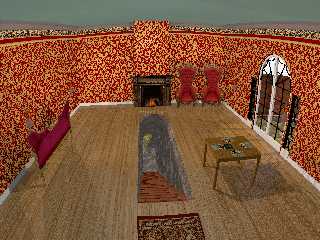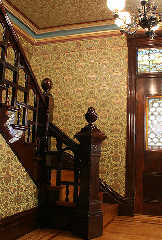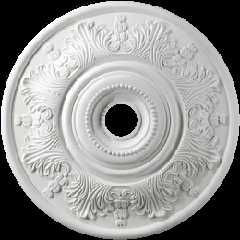 |
 |
|
 |
|
 |
|  |
|  |
|
 |
|
 |
|  |
|  |
|
 |
> Well, I like the sketch/design and it does look Victorian so I think it might be
> the brick wall around it in your image that is making it look out of place.
I don't have a firm idea of what Victorian looks like vs Edwardian or
Kardashian.... :)
> Always the problem I have commenting on WIP's, I never am quite sure what part
> are more WIP than others ;-)
It's all up for grabs at this point. Have at it.
Other than the French doors that I'm not up for remodeling right now, and the
basic tunnel, it's all pretty much just a sketch with some texturing.
I'm looking to redo the room in wallpaper as suggested, add curtains, framed
paintings and mirrors, jazz up the fireplace with an ornate hearth and some
brass fireplace tools, do some work on the card table, and then maybe redo the
lighting. I need some plants in the conservatory as well.
I'm not sure I'm happy with the little desk-lamps - I might see if I can do
something ceiling-mounted.
Part of why I wanted to take a stab at this is to learn how to do certain
things, do them better, and do them FASTER. So, other than just the usual
comments and suggestions about the scene and its elements, I'm open and happy to
hear any and all suggestions about how to envision, arrange, and construct a
scene, lay out my SDL for efficient editing and revision, and where I can
benefit by using macros, loops, and interesting "tricks" folks have developed
throughout the years. I'm loving the ability to render only a small section of
the WIP by selecting a box or using the command line options. I haven't really
used Quick Colors, but often find myself rendering at Q5 - though that really
freaks me out sometimes when I forget it's set to that and certain features
(obviously) don't show up or are black). Classic noob stuff. :D
Post a reply to this message
|
 |
|  |
|  |
|
 |
|
 |
|  |
|  |
|
 |
So, I've spent a little while reworking some of this, and the thing that struck
me is how rich the image maps come out, and how dull and lifeless the
eye-dropper tool sampled rgb colors come out when I try to incorporate them into
a color map.
Maybe it's related to my monitor / gamma / contrast (non)issue, maybe I'm doing
something wrong using (rgb_value/255), or maybe it's just an optical effect of
not having any real texturing of the basic pigment.
Whatever's going on, my floor is NOT coming out anywhere close to the rich honey
yellow of the reference photo.
I could use some schooling in this area if anyone has any experience/insights.
See the wood floor I color-sampled compared to the present WIP.
I DID notice that moving the order of the colors around in the color map can
have an interesting effect, though I haven't stumbled upon what I'd like yet.
#declare OakFloor = texture {
pigment {bozo scale <1, 1, 10> color_map {
[0.0 rgb <121/255, 52/255, 13/255> * Tone]
[0.2 rgb <142/255, 73/255, 18/255> * Tone]
[0.4 rgb <184/255, 115/255, 48/255> * Tone]
[0.6 rgb <157/255, 81/255, 23/255> * Tone]
[0.8 rgb <108/255, 45/255, 4/255> * Tone]
[1.0 rgb <156/255, 72/255, 26/255> * Tone]
}
turbulence 0.5
scale <1, 1, 10> * 0.5
rotate y*YRotate
}
Post a reply to this message
Attachments:
Download 'secretpassage6.png' (646 KB)
Preview of image 'secretpassage6.png'

|
 |
|  |
|  |
|
 |
|
 |
|  |
|  |
|
 |
Reference:
Post a reply to this message
Attachments:
Download 'centennial_foyer.jpg' (137 KB)
Preview of image 'centennial_foyer.jpg'

|
 |
|  |
|  |
|
 |
|
 |
|  |
|  |
|
 |
At first glance, I would say that - as is - the /colour/ of the floor is
oak-like, although a light one. However, I think you should do a couple
of things:
1) break up the floor in individual boards. In this wip, boards are
simulated by scaling the texture to the extreme but that is not
wood-like. In the thread 'Silentium - final' I uploaded an older image
of mine (De Dulle Griet) where you can see different wood textures,
particularly the floor which is a macro originally by Dan Hentschel
which I adapted to my own needs. If you are interested, I can put it in
p.b.s-f.
2) use a wood pattern properly scaled and rotated. Now, you will soon
discover that moiree effects will appear when applied to the floor. You
will need to play with the texture's scale and/or the colour contrasts
until they disappear.
3) if you want a more honey-coloured floor I suppose you should add more
'yellow' to your texture ;-) I shall look at your texture but be
patient: I am rendering a final version of Silentium and that is taking
most of my resources for the reminder of the week.
Thomas
Post a reply to this message
|
 |
|  |
|  |
|
 |
|
 |
|  |
|  |
|
 |
On 8-10-2014 20:53, Bald Eagle wrote:
> Whatever's going on, my floor is NOT coming out anywhere close to the rich honey
> yellow of the reference photo.
Try this. I believe it comes closer to what you want:
#local Tone = <1.2, 1.2, 0.3>;
#declare OakFloor =
texture {
pigment {
wood
color_map {
[0.0 srgb <121, 52, 13>/255 * Tone]
[0.2 srgb <142, 73, 18>/255 * Tone]
[0.4 srgb <184, 115, 48>/255 * Tone]
[0.6 srgb <157, 81, 23>/255 * Tone]
[0.8 srgb <108, 45, 4>/255 * Tone]
[1.0 srgb <156, 72, 26>/255 * Tone]
}
warp {turbulence <0.6, 0.1, 0.1>}
scale <1, 1, 10>*0.5
scale 0.3
rotate 1*x
rotate y*10
}
}
You could also experiment with the following texture by Nicolas Rougier,
which is an excellent wood texture:
//============= NR_Wood (2003) =============
#declare NR_wood_grain =
pigment {
wood
warp {cylindrical orientation y dist_exp 1}
warp {turbulence 1.25}
scale <.5,30,1>
warp {turbulence .25}
scale <1,10,1>
warp {
black_hole <0, 0.5, 0>, 1
falloff 2
strength 1.5
repeat 7
turbulence 2
inverse
}
}
#declare NR_wood_normal =
function {
pigment {
wood
warp {cylindrical orientation y dist_exp 1}
warp {turbulence 1.25}
scale <.5,30,1>
warp {turbulence .25}
scale <1,5,1>
color_map {[0 rgb <0,0,0>] [1 rgb <1,1,1>]}
}
}
#declare NR_woodmap =
color_map {
[0.00 srgb <0.949, 0.792, 0.514 >]
[0.30 srgb <0.855, 0.651, 0.376 >]
[0.60 srgb <0.831, 0.596, 0.275 >]
[0.90 srgb <0.620, 0.447, 0.204 >]
}
#declare NR_Wood =
texture {
pigment {NR_wood_grain
color_map {NR_woodmap}
ramp_wave
}
normal {
function {NR_wood_normal(x,y,z).grey*0.5
}
}
finish {diffuse 0.6 specular 0.1 roughness 0.005}
}
Thomas
Post a reply to this message
|
 |
|  |
|  |
|
 |
|
 |
|  |
|  |
|
 |
> "Bald Eagle" <cre### [at] netscape net> wrote:
>>
>> well, not having any real idea what constituted a "conservatory", neither did I,
>> but I searched around to get an overall idea of what a Victorian conservatory
>> might look like, and went with the attached design.
>>
>
> Well, I like the sketch/design and it does look Victorian so I think it might be
> the brick wall around it in your image that is making it look out of place.
>
>>
>> Holy smokes. That must have been a really massive investment of time and
>> brainpower!
>
> Oh yes, back in the days when I had time to spend ages modelling (but not enough
> time to RTM and workout how to use loops ;-)
>
>> If I'm not AFK due to work IRL, then I'll make a stab at working on constructing
>> scene elements, experimenting with camera angle and lighting, and enriching my
good-enough-to-get-the-idea textures.
> :)
>
> Always the problem I have commenting on WIP's, I never am quite sure what part
> are more WIP than others ;-)
>
> Sean
>
>
>
As you made that trone way back in 1998, i'm not sure that loops where
possible at that time. Early 3.0 or late 2.x versions. net> wrote:
>>
>> well, not having any real idea what constituted a "conservatory", neither did I,
>> but I searched around to get an overall idea of what a Victorian conservatory
>> might look like, and went with the attached design.
>>
>
> Well, I like the sketch/design and it does look Victorian so I think it might be
> the brick wall around it in your image that is making it look out of place.
>
>>
>> Holy smokes. That must have been a really massive investment of time and
>> brainpower!
>
> Oh yes, back in the days when I had time to spend ages modelling (but not enough
> time to RTM and workout how to use loops ;-)
>
>> If I'm not AFK due to work IRL, then I'll make a stab at working on constructing
>> scene elements, experimenting with camera angle and lighting, and enriching my
good-enough-to-get-the-idea textures.
> :)
>
> Always the problem I have commenting on WIP's, I never am quite sure what part
> are more WIP than others ;-)
>
> Sean
>
>
>
As you made that trone way back in 1998, i'm not sure that loops where
possible at that time. Early 3.0 or late 2.x versions.
Post a reply to this message
|
 |
|  |
|  |
|
 |
|
 |
|  |
|  |
|
 |
> So, I've spent a little while reworking some of this, and the thing that struck
> me is how rich the image maps come out, and how dull and lifeless the
> eye-dropper tool sampled rgb colors come out when I try to incorporate them into
> a color map.
>
When using the eye-dropper, it's often good to, at least slightly, blur
the image.
Another thing to do is to zoom in by a large value. Here, zooming by 10x
or more can realy help.
You can always add a "varnish" to your floor by adding a layered texture
with a fully filtering yellow/golden hue. That top layer can also be
used to controll the reflection and highlights.
Post a reply to this message
|
 |
|  |
|  |
|
 |
|
 |
|  |
|  |
|
 |
I'm about done with edits for the day.
Thomas - thank you for sharing some of your texture collection. I took some
time and fiddled with the second texture, jimmied the color map, and scaled it.
That seemed to give me a good start.
Laid down a loop of randomized boards for the floor - still needs work, I'd say.
Worked on the border and molding at the top of the fireplace. Too stupid today
to difference the bevels. Sometimes it's the simplest things that thwart me.
:\
Brick step texture is still botched.
Edited both stones.inc files to change everything to srgbt - maybe there's a
difference, but it's small. Might have to snip out the ones I'm using and tweak
all of those textures in a special include file.
Tomorrow I think I'm going to work on adding ceiling fixtures and seeing what I
can do to make some real furniture. THAT's gonna be a bit of a sticky wicket
for sure.
I was thinking about UV-mapping an SDL object with a ceiling medallion, but that
turned out to be an exercise in mind-bending frustration. So many mapping types
and options and how to go about nesting what in what...
Is there a complete list of the mapping types? all I found was
2.7.4.2 Map type constants
Plane_Map = 0
Sphere_Map = 1
Cylinder_Map = 2
Torus_Map = 5
But the docs say there is mapping for
bicubic_patch, box, lathe, sor, mesh, mesh2, ovus, parametric, sphere, and
torus. What are the numerical constants for these?
Post a reply to this message
Attachments:
Download 'medallion1.png' (82 KB)
Preview of image 'medallion1.png'

|
 |
|  |
|  |
|
 |
|
 |
|  |
|  |
|
 |
Am 10.10.2014 05:45, schrieb Bald Eagle:
> I was thinking about UV-mapping an SDL object with a ceiling medallion, but that
> turned out to be an exercise in mind-bending frustration. So many mapping types
> and options and how to go about nesting what in what...
>
> Is there a complete list of the mapping types? all I found was
>
> 2.7.4.2 Map type constants
> Plane_Map = 0
> Sphere_Map = 1
> Cylinder_Map = 2
> Torus_Map = 5
>
> But the docs say there is mapping for
> bicubic_patch, box, lathe, sor, mesh, mesh2, ovus, parametric, sphere, and
> torus. What are the numerical constants for these?
These are two separate things:
(1) In POV-Ray, the concept of a texture is generally 3-dimensional;
objects can be thought of as being cut out of a 3D material. This is
also true when you use an image_map: The 2D texture is "extruded" into
the 3rd dimension, normally using a simple orthographic projection. The
map_type can be used to change this projection.
(2) UV-mapping takes a single slice of a (3D) texture, and maps it onto
the surface of a given geometric primitive according to rules specific
to that primitive. There is generally no way to change this mapping,
unless the primitive explicitly allows to specify UV mapping coordinates
(such as mesh or mesh2).
Normally, when you use UV-mapping, you specifiy map_type 0 (or no
map_type at all, as it is the default), so that the texture slice taken
for the UV mapping is identical with the original image.
Post a reply to this message
|
 |
|  |
|  |
|
 |
|
 |
|  |
|  |
|
 |
clipka <ano### [at] anonymous org> wrote:
> These are two separate things:
Well, ok, my original statement should have been "somehow mapping" instead of
specifically uv-mapping, it just came out that way since I intuited that the uv
method might be best suited. :)
The counting still seems weird, like the way ACLU or Microsoft counts. 0, 1, 2,
5. Who do I need to have induct me into the inner circle, what blood sacrifice
needs to be made for me to pierce the veil of the Inner Mysteries of POV-Ray
mapping codes? Are those missing constants are only known to the 3&4th Degree
Master Masons? I'm guessing they map a _pyramidal_ sweep, or the obverse of
worthless Federal Reserve Notes...
I might see if I can mesh model something, but I haven't really ever used a mesh
modeler. Not looking forward to making all those acanthus leaves and
scrollwork...
A heightfield might give me something I could image map just to see if I like
one particular design more than another. Though a nicely shaded planar image
map would likely serve the same purpose.
Lastly, I was toying with cobbling together an SDL object that would mimic the
gross contours of the object and then image map over that to quickly give a
textured object with an actual 3D shape. Worth doing?
{"No, you dolt - use a modeler, or perform another blood sacrifice and be
inculcated with the sacred power of POV SDL....") org> wrote:
> These are two separate things:
Well, ok, my original statement should have been "somehow mapping" instead of
specifically uv-mapping, it just came out that way since I intuited that the uv
method might be best suited. :)
The counting still seems weird, like the way ACLU or Microsoft counts. 0, 1, 2,
5. Who do I need to have induct me into the inner circle, what blood sacrifice
needs to be made for me to pierce the veil of the Inner Mysteries of POV-Ray
mapping codes? Are those missing constants are only known to the 3&4th Degree
Master Masons? I'm guessing they map a _pyramidal_ sweep, or the obverse of
worthless Federal Reserve Notes...
I might see if I can mesh model something, but I haven't really ever used a mesh
modeler. Not looking forward to making all those acanthus leaves and
scrollwork...
A heightfield might give me something I could image map just to see if I like
one particular design more than another. Though a nicely shaded planar image
map would likely serve the same purpose.
Lastly, I was toying with cobbling together an SDL object that would mimic the
gross contours of the object and then image map over that to quickly give a
textured object with an actual 3D shape. Worth doing?
{"No, you dolt - use a modeler, or perform another blood sacrifice and be
inculcated with the sacred power of POV SDL....")
Post a reply to this message
|
 |
|  |
|  |
|
 |
|
 |
|  |
|
 |




![]()